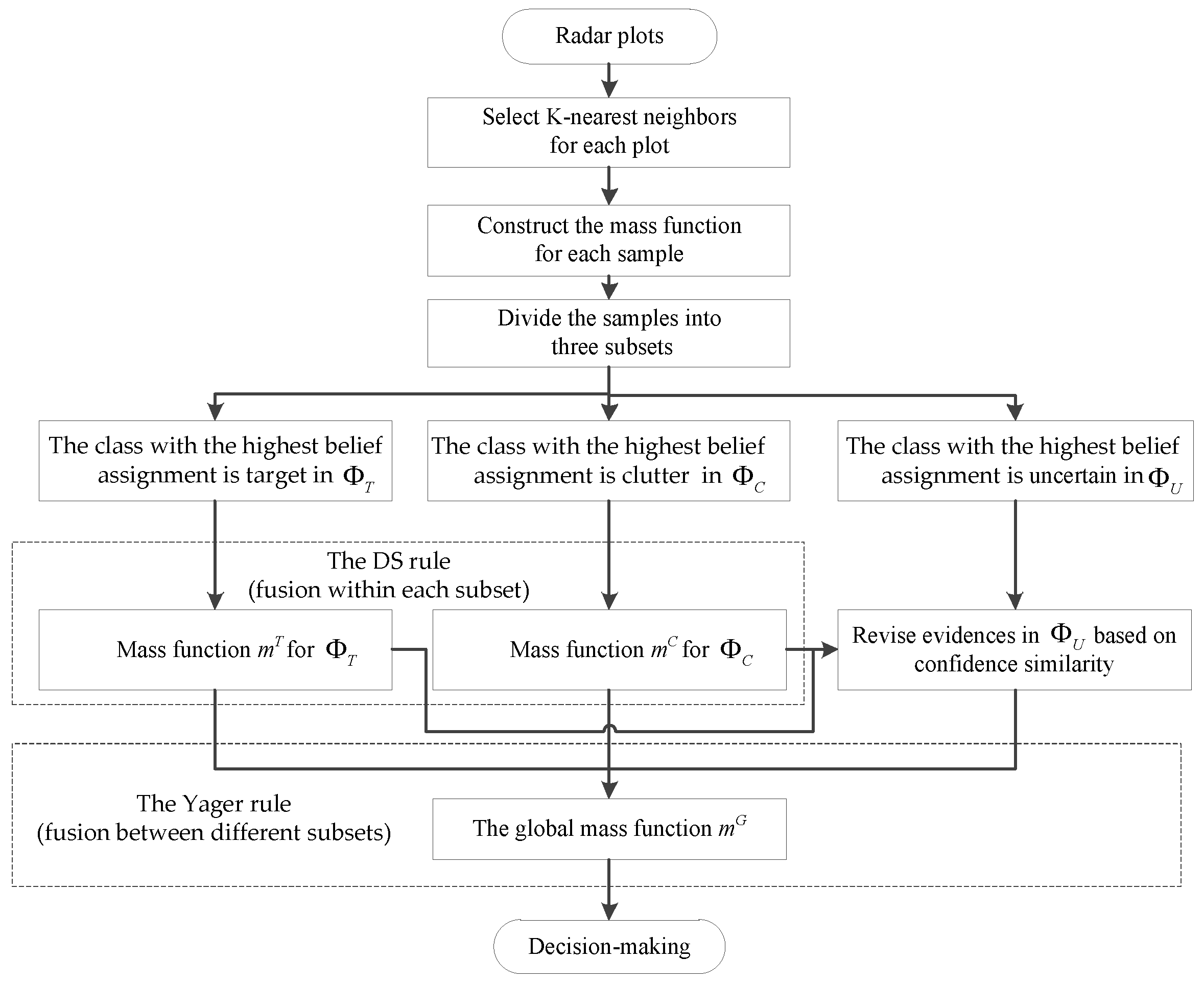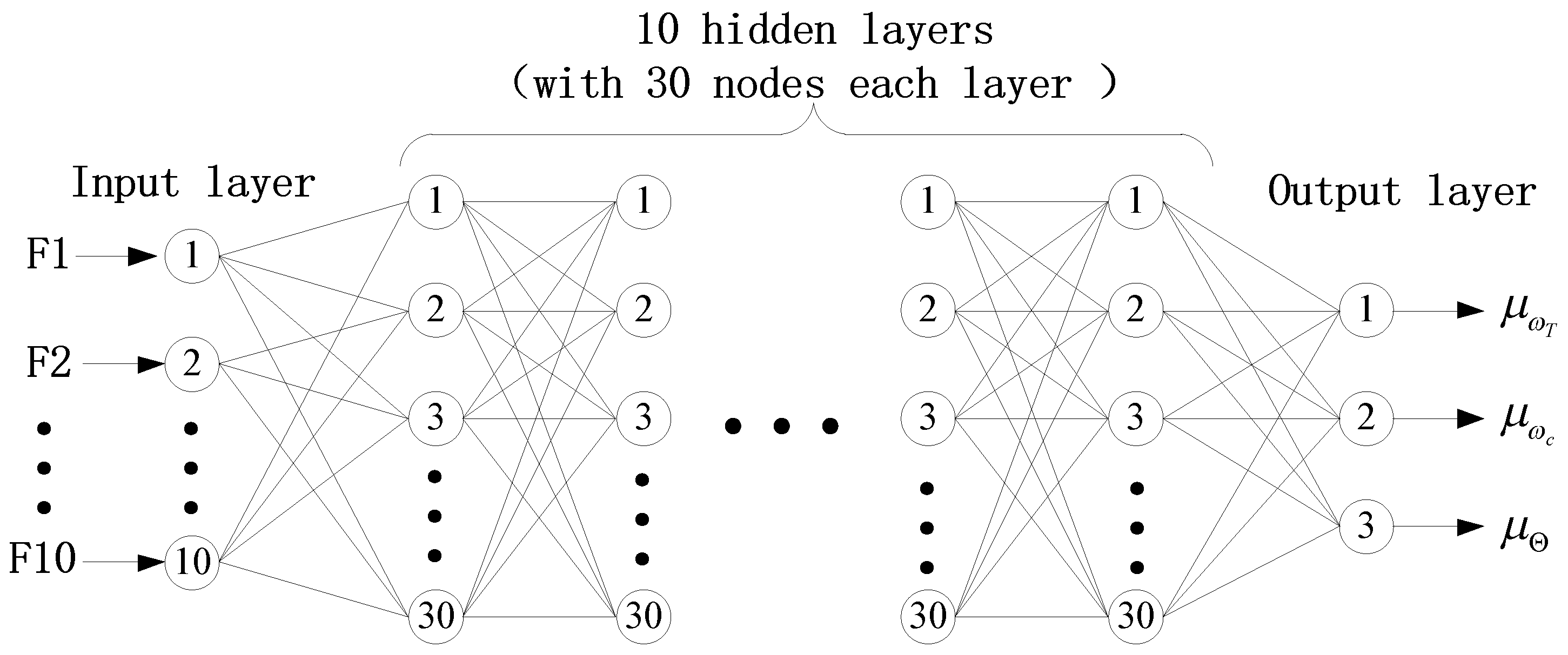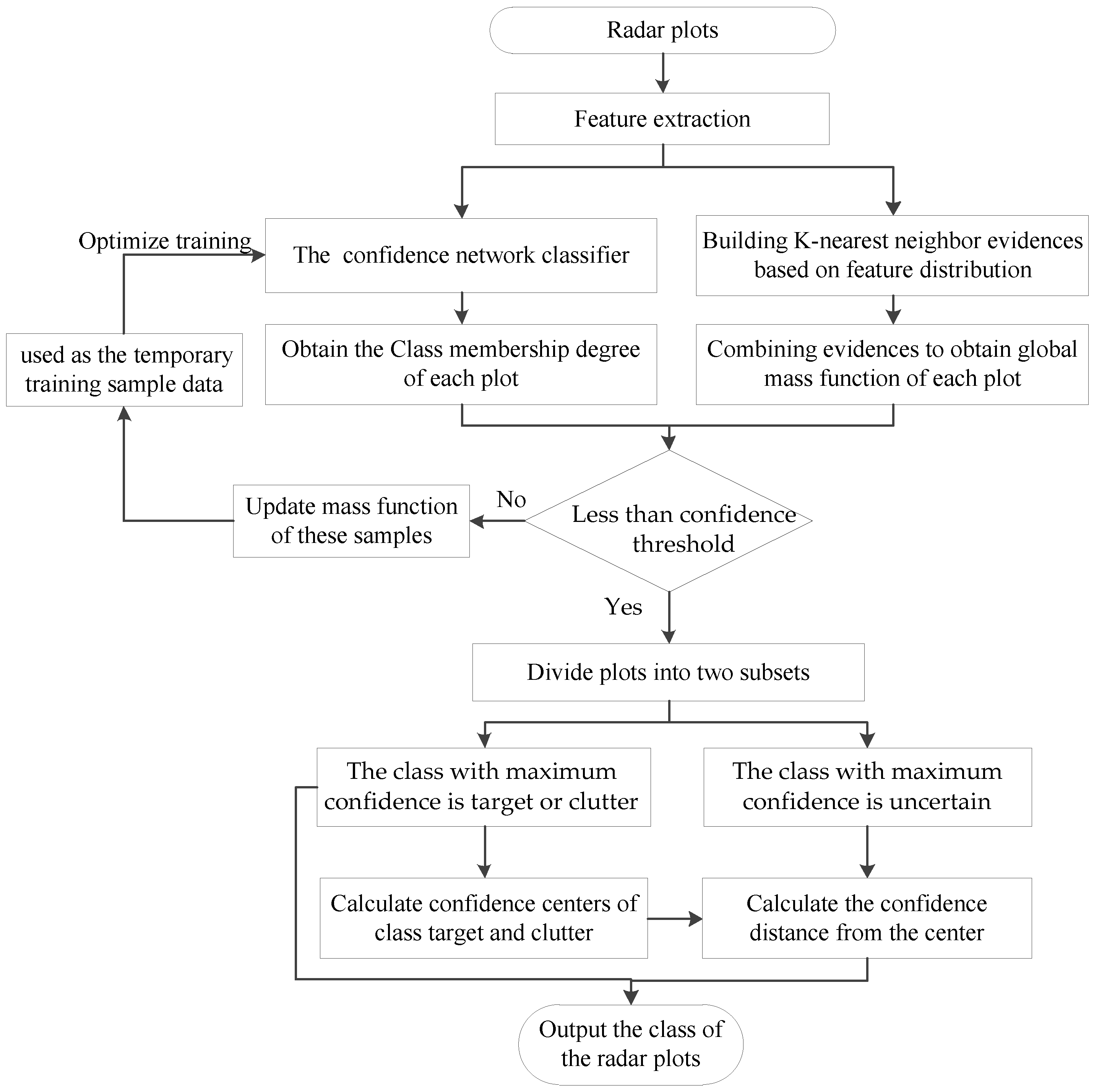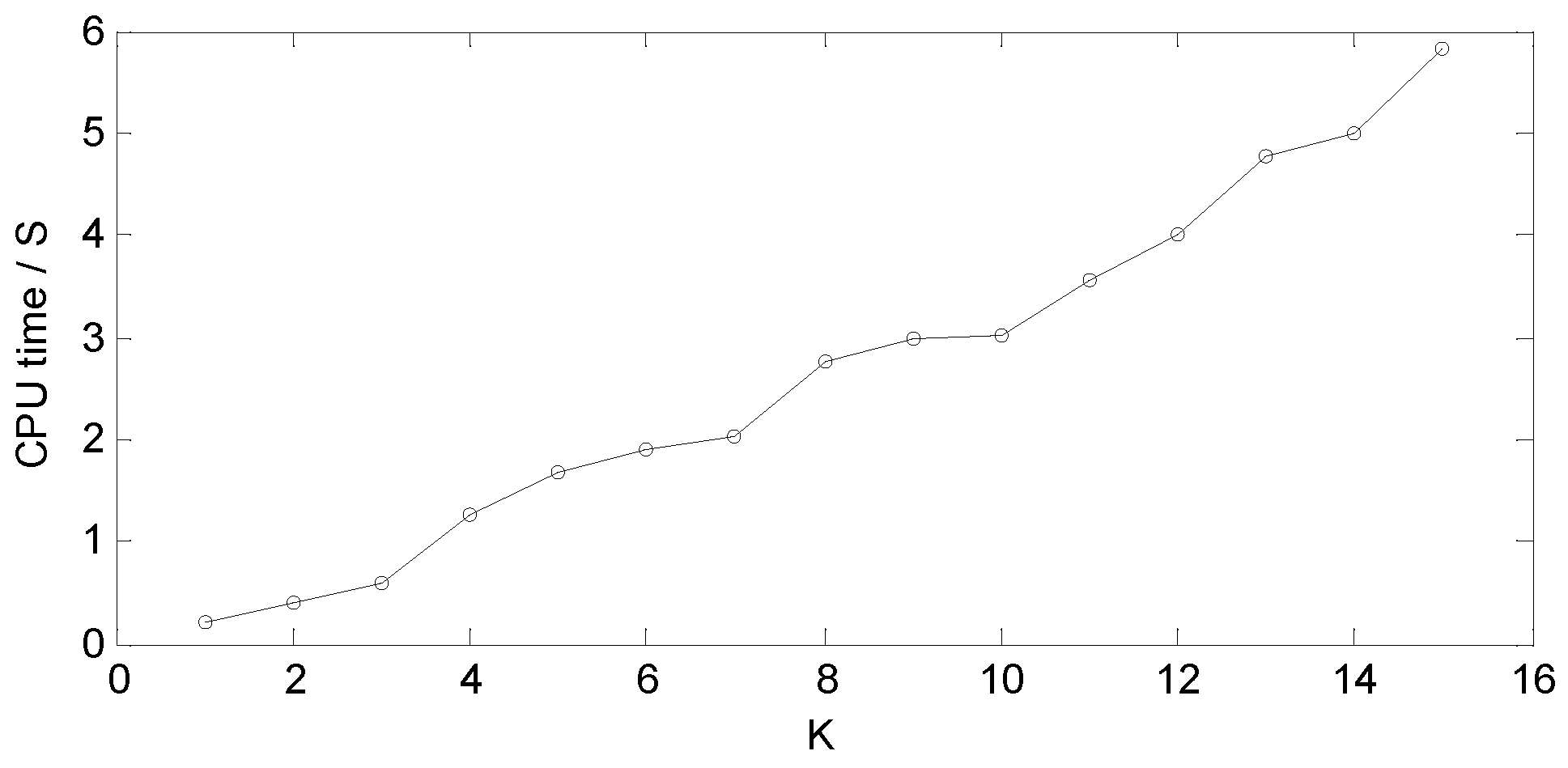RPC-EAU: Radar Plot Classification Algorithm Based on Evidence Adaptive Updating
Abstract
:Featured Application
Abstract
1. Introduction
2. Related Work
2.1. Belief Functions
2.2. Evidence Classification
2.3. Intelligent Radar Plot Classification
3. Proposed Method
3.1. Radar Plots Feature Extraction
3.2. Construction of Belief Function
3.3. Correction and Combination of Evidences
3.4. Design and Update of Confidence Classification Network
3.4.1. Classifier Design
3.4.2. Classifier Optimization
3.5. Algorithm Performance Evaluation
| Algorithm 1 RPC-EAU algorithm |
| Require: Radar plots set ; training set ; confidence threshold ; number of decision evidences K; confidence network classifier; Initialization: The initial offline training of the confidence classification network is carried out based on this training set. 1: Extract features from each radar plot in set . 2: t ← 0; 3: Repeat 4: Obtain the class membership of each sample based on the confidence classification network. 5: Select K-nearest neighbor samples based on the feature distribution of these samples. Construct and combine evidences to obtain the global mass function for each sample . 6: Calculate the confidence distance between and of each sample. 7: Divide the samples with a confidence distance less than the confidence threshold into two subsets and . 8: Output the classification results of the samples in subset . At the same time, calculate the class centers of these samples. 9: For the samples in subset , calculate their confidence distances from the class center and separately. 10: Assign the samples to the class with the minimum confidence distance in sequence. 11: For those remaining samples whose confidence distance is greater than the threshold , correct their evidences using Equation (35). 12: Optimize training confidence network classifiers by using these modified evidences. 13: t ← t + 1. 14: until there are no samples with confidence distance exceeding threshold . 15: return the class labels of each radar plot. |
4. Experiments
4.1. Synthetic Dataset
4.2. Classification Performance
4.3. Parameter Analysis
4.4. Evidence Update Times
4.5. Application in Real Traffic Control Radar Data
5. Conclusions
Author Contributions
Funding
Institutional Review Board Statement
Informed Consent Statement
Data Availability Statement
Acknowledgments
Conflicts of Interest
References
- He, Y.; Xiu, J.J.; Liu, Y. Radar Data Processing with Applications, 4th ed.; Electronic Industry Press: Beijing, China, 2022. [Google Scholar]
- Luo, X.W.; Zhang, B.Y.; Liu, J. Researches on the Method of Clutter Suppression in Radar Data Processing. Syst. Eng. Electron. 2016, 38, 37–44. [Google Scholar]
- Duan, C.D.; Han, C.L.; Yang, Z.W. Inshore ambiguity clutter suppression method aided by clutter classification. J. Xidian Univ. 2021, 48, 64–71. [Google Scholar]
- Lin, Q.; Peng, W.; Hu, X.J. Method of Radar Plot True and False Identification Based on Improved KNN. Mod. Radar 2020, 42, 41–45. [Google Scholar]
- Peng, W.; Lin, Q. An Identification Method of True and False Plots Based on PSO-SVM Algorithm. Radar Sci. Technol. 2021, 49, 429–437. [Google Scholar]
- Sun, W.F.; Zhao, L.L.; Ji, Y.G. A false plot identification method based on multi frame clustering for compact HFSWR. Syst. Eng. Electron. 2024, 46, 419–427. [Google Scholar]
- Ma, Y.Z. A Track Screening Algorithm Based on Support Vector Machine. Acoust. Electron. Eng. 2022, 146, 10–13, 18. [Google Scholar]
- Zhang, Y.; Zhang, X.D. True and False Identification Method for Radar Plot Based on Neural Network. Shipboard Electron. Countermeas. 2023, 46, 80–83. [Google Scholar]
- Qi, Y.; Yu, C.; Dai, X. Research on Radar Plot Classification Based on Fully Connected Neural Network. In Proceedings of the 2019 3rd Interna-tional Conference on Electronic Information Technology and Computer Engineering, Xiamen, China, 18–20 October 2019; pp. 698–703. [Google Scholar]
- Liu, Z.; Qi, Y.; Dai, X. Radar Plot Classification Based on Machine Learning. In Proceedings of the 2021 5th International Conference on Electronic Information Technology and Computer Engineering, Tianjin, China, 29–31 October 2021; pp. 537–541. [Google Scholar]
- Wang, H.; Dou, X.H.; Tian, K.Y. Radar Track Classification Method Based on CNN. Shipboard Electron. Countermeas. 2023, 46, 70–74. [Google Scholar]
- Qi, Y.M.; Liu, Z.C.; Yu, C.Z. Research into The Classification Techniques of Radar Plots Based on CNN. Shipboard Electron. Countermeas. 2021, 44, 53–57, 82. [Google Scholar]
- Liu, Z.; Qi, Y.; Dai, X. Radar Plot Classification Method Based on Recurrent Neural Network. In Proceedings of the 2020 4th International Conference on Electronic Information Technology and Computer Engineering, Dali, China, 17–19 July 2020; pp. 611–615. [Google Scholar]
- Peng, W.; Lin, Q. Research on plot authenticity identification method based on PSO-MLP. J. Phys. Conf. Ser. 2020, 1486, 042003. [Google Scholar] [CrossRef]
- Peng, W.; Lin, Q. Research into Plot True and False Identification Method Based on PSO-MLP. Shipboard Electron. Countermeas. 2020, 43, 80–85. [Google Scholar]
- Zhu, X.C.; Zhou, L.; Zhang, Y.T. Plot filter algorithm based on PF-Net. Radar ECM 2022, 42, 19–22, 38. [Google Scholar]
- Meng, W.H.; Lin, Q. The Identification Method of True and False Plots Based on PSO-PNN Algorithm. Comput. Simul. 2022, 39, 11–15. [Google Scholar]
- Dempster, A.P. Upper and lower probabilities induced by a multi-valued mapping. Ann. Math. Stat. 1967, 38, 325–339. [Google Scholar] [CrossRef]
- Shafer, G. A Mathematical Theory of Evidence; Princeton University Press: Princeton, NJ, USA, 1976. [Google Scholar]
- Denoeux, T. 40 years of Dempster-Shafer theory. Int. J. Approx. Reason. 2016, 79, 1–6. [Google Scholar] [CrossRef]
- Denoeux, T. A k-nearest neighbor classification rule based on Dempster-Shafer theory. IEEE Trans. Syst. Man Cybern. 1995, 25, 804–813. [Google Scholar] [CrossRef]
- Ma, Z.F.; Tian, H.P.; Liu, Z.C.; Zhang, Z.W. A new incomplete pattern belief classification method with multiple estimations based on KNN. Appl. Soft. Comput. 2020, 90, 106175. [Google Scholar] [CrossRef]
- Meng, J. Research and Application of Data Classification Based on the Theory of Belief Functions; University of Science and Technology Beijing: Beijing, China, 2021. [Google Scholar]
- Liu, Z.G.; Qiu, G.H.; Mercier, G.; Pan, Q. A transfer classification method for heterogeneous data based on evidence theory. IEEE Trans. Syst. Man Cybern. Syst. 2021, 51, 5129–5141. [Google Scholar] [CrossRef]
- Liu, S.T.; Li, X.J.; Zhou, Z.J. Review on the application of evidence theory in patten classification. J. CAEIT 2022, 17, 247–258. [Google Scholar]
- Zhang, Z.; Tian, H.; Yan, L.; Martin, A.; Zhou, K. Learning a creedal classifier with optimized and adaptive multiestimation for missing data imputation. IEEE Trans. Syst. Man Cybern. Syst. 2022, 52, 4092–4104. [Google Scholar] [CrossRef]
- Liu, Z.G.; Pan, Q.; Dezert, J.; Mercier, G. Credal c-means clustering method based on belief functions. Knowl.-Based Syst. 2015, 74, 119–132. [Google Scholar] [CrossRef]
- Denoeux, T.; Sriboonchitta, S.; Kanjanatarakul, O. Evidential clustering of large dissimilarity data. Knowl.-Based Syst. 2016, 106, 179–195. [Google Scholar] [CrossRef]
- Denoeux, T.; Kanjanatarakul, O. Evidential clustering: A review. In Proceedings of the 5th International Symposium on Integrated Uncertainty in Knowledge Modelling and Decision Making, Da Nang, Vietnam, 30 November–2 December 2016; pp. 24–35. [Google Scholar]
- Zhang, Z.; Liu, Z.; Martin, A.; Zhou, K. Dynamic evidential clustering algorithm. Knowl.-Based Syst. 2021, 213, 106643. [Google Scholar] [CrossRef]
- Denoeux, T. NN-EVCLUS: Neural network-based evidential clustering. Inf. Sci. 2021, 572, 297–330. [Google Scholar] [CrossRef]
- Jiao, L.; Denoeux, T.; Liu, Z.-G.; Pan, Q. EGMM: An evidential version of the gaussian mixture model for clustering. Appl. Soft Comput. 2022, 129, 109619. [Google Scholar] [CrossRef]
- Xie, B.L. Research on Muli-Sensor Data Fusion Method Based on DS Evidence Theory; Henan University: Kaifeng, China, 2022. [Google Scholar]
- Denoeux, T. Decision-Making with Belief Functions: A Review. Int. J. Approx. Reason. 2019, 109, 87–110. [Google Scholar] [CrossRef]
- Liu, Z.G.; Zhang, X.; Niu, J.; Dezert, J. Combination of Classifiers With Different Frames of Discernment Based on Belief Functions. IEEE Trans. Fuzzy Syst. 2021, 29, 1764–1774. [Google Scholar] [CrossRef]
- Lian, C.; Ruan, S.; Denoeux, T.; Li, H.; Vera, P. Spatial evidential clustering with adaptive distance metric for tumor segmentation in FDGPET images. IEEE Trans. Biomed. Eng. 2017, 65, 21–30. [Google Scholar] [CrossRef]
- Lian, C.; Ruan, S.; Denoeux, T.; Li, H.; Vera, P. Joint tumor segmentation in PET-CT images using co-clustering and fusion based on belief functions. IEEE Trans. Image Process. 2018, 28, 755–766. [Google Scholar] [CrossRef] [PubMed]
- Liu, S.; Guo, X.J.; Zhang, L.Y. FMEA evaluation of all-electric ship propulsion Based on fuzzy confidence theory. Control Eng. China 2021, 28, 1807–1813. [Google Scholar]
- Han, X.X.; Wang, J.; Chen, Y. Safety assessment of water supply and drainage based on evidential reasoning rule. Sci. Technol. Eng. 2021, 21, 13758–13764. [Google Scholar]
- He, K.X.; Wang, T.; Su, Z.Y. Improved abnormal condition detection based on evidence K-nearest neighbor and its Application. Control Eng. China 2022, 29, 655–660. [Google Scholar]
- Abdelkhalek, R.; Boukhris, I.; Elouedi, Z. An evidential collaborative filtering approach based on items contents clustering. In Belief Functions: Theory and Applications, Proceedings of the 5th International Conference, BELIEF 2018, Compiègne, France, 17–21 September 2018; Springer International Publishing: Berlin/Heidelberg, Germany; pp. 1–9.
- Abdelkhalek, R.; Boukhris, I.; Elouedi, Z. An evidential clustering for collaborative filtering based on users preferences. In Modeling Decisions for Artificial Intelligence, Proceedings of the 16th International Conference, MDAI 2019, Milan, Italy, 4–6 September 2019; Springer International Publishing: Berlin/Heidelberg, Germany, 2019; pp. 224–235. [Google Scholar]
- Yang, R.; Zhao, Y.B.; Shi, Y. RPREC: A Radar Plot Recognition Algorithm Based on Adaptive Evidence Classification. Appl. Sci. 2023, 13, 12511. [Google Scholar] [CrossRef]
- Yang, R.; Zhao, Y.; Yang, T. A recognition algorithm of radar plots based on confidence function and self-updating classifier. Sci. Technol. Eng. 2023, 23, 8236–8242. [Google Scholar]









| Symbol | Feature Information | The Specific Meaning of Feature Information |
|---|---|---|
| R | Range | The distance between target and radar |
| A | Azimuth | The azimuth of the target in the radar coordinate |
| E | Elevation | The elevation angle of the target in the radar coordinate |
| Dw | Distance width | The width of target at distance can be characterized by the number of distance resolution units |
| Aw | Azimuth width | The width of target in azimuth can be characterized by the number of azimuth resolution units |
| Tn | Total number of resolution units | The number of units contained in the range and azimuth resolution area of the target |
| Amax | Maximum amplitude | The maximum amplitude of the echo participating in condensation |
| Amin | Minimum amplitude | The minimum amplitude of the echo participating in condensation |
| Aa | Average amplitude | The average amplitude of the echo participating in condensation |
| Et | Number of resolution units exceeding threshold | The number of units participating in plot condensation that exceed the threshold |
| Mass Function | #1 | #2 | #3 | #4 |
|---|---|---|---|---|
| 1 | 0 | 0.641 | 0 | |
| 0 | 0.895 | 0 | 0 | |
| 0 | 0.105 | 0.359 | 1 |
| Mass Function | K Nearest Neighbor Evidence | |||||
|---|---|---|---|---|---|---|
| #1 | #2 | #3 | #4 | #5 | #6 | |
| 0.8 | 0 | 0.9 | 0 | 0 | 0 | |
| 0 | 0.5 | 0 | 0.4 | 0.2 | 0 | |
| 0.2 | 0.5 | 0.1 | 0.6 | 0.8 | 1 | |
| Mass Function | |||||
|---|---|---|---|---|---|
| 0.98 | 0 | 0.235 | 0.355 | 0.391 | |
| 0 | 0.76 | 0.015 | 0.471 | 0.363 | |
| 0.02 | 0.24 | 0.75 | 0.174 | 0.246 |
| Sample | Class Label | Total | ||
|---|---|---|---|---|
| Number | 372 | 263 | 86 | 721 |
| Order | Sample Type | Number of Samples in Each Class | ||
|---|---|---|---|---|
| Exp. 1 | Training samples | 191 | 122 | 48 |
| Test samples | 181 | 141 | 38 | |
| Exp. 2 | Training samples | 182 | 137 | 42 |
| Test samples | 190 | 126 | 44 | |
| Exp. 2 | Training samples | 174 | 141 | 46 |
| Test samples | 198 | 122 | 40 | |
| Indicators | The Statistical Results of Each Algorithm | |||||
|---|---|---|---|---|---|---|
| PSO-SVM | IKNN | RPC-FNN | RPC-RNN | RPREC | RPC-EAU | |
| 0.860 | 0.867 | 0.918 | 0.936 | 0.958 | 0.961 | |
| 0.117 | 0.099 | 0.052 | 0.043 | 0.025 | 0.024 | |
| 0.835 | 0.829 | 0.887 | 0.913 | 0.942 | 0.945 | |
| (s) | 0.21 | 0.52 | 1.13 | 2.37 | 24.21 | 2.87 |
| The Evaluation Indicators | ||||
|---|---|---|---|---|
| CPU Time (s) | ||||
| 0.1 | 0.953 | 0.013 | 0.943 | 2.98 |
| 0.2 | 0.949 | 0.019 | 0.951 | 2.76 |
| 0.3 | 0.913 | 0.022 | 0.923 | 2.03 |
| 0.4 | 0.899 | 0.031 | 0.889 | 1.89 |
| 0.5 | 0.876 | 0.043 | 0.876 | 1.58 |
| 0.6 | 0.841 | 0.049 | 0.861 | 1.57 |
| 0.7 | 0.837 | 0.046 | 0.857 | 0.89 |
| 0.8 | 0.835 | 0.052 | 0.845 | 0.49 |
| 0.9 | 0.819 | 0.053 | 0.824 | 0.31 |
| The Property Parameter | The Experimental Statistical Results of RPC-EAU | ||||
|---|---|---|---|---|---|
| Evidence update times | 100 | 200 | 300 | 400 | 500 |
| CPU time (s) | 0.75 | 1.44 | 2.15 | 2.85 | 3.57 |
| Radar Plots | Class Label | Total | ||
|---|---|---|---|---|
| Number | 142 | 1531 | \ | 1673 |
| Indicators | The Statistical Results of Each Algorithm | |||||
|---|---|---|---|---|---|---|
| PSO-SVM | IKNN | RPC-FNN | RPC-RNN | RPREC | RPC-EAU | |
| 124 | 130 | 134 | 135 | 140 | 140 | |
| 18 | 12 | 8 | 7 | 2 | 2 | |
| 1309 | 1284 | 1373 | 1382 | 1434 | 1452 | |
| 222 | 247 | 158 | 149 | 97 | 79 | |
| 0.857 | 0.845 | 0.901 | 0.907 | 0.941 | 0.952 | |
| 0.127 | 0.089 | 0.062 | 0.053 | 0.021 | 0.019 | |
| 0.855 | 0.839 | 0.897 | 0.903 | 0.937 | 0.949 | |
| (s) | 0.37 | 0.92 | 3.39 | 3.59 | 33.79 | 3.87 |
Disclaimer/Publisher’s Note: The statements, opinions and data contained in all publications are solely those of the individual author(s) and contributor(s) and not of MDPI and/or the editor(s). MDPI and/or the editor(s) disclaim responsibility for any injury to people or property resulting from any ideas, methods, instructions or products referred to in the content. |
© 2024 by the authors. Licensee MDPI, Basel, Switzerland. This article is an open access article distributed under the terms and conditions of the Creative Commons Attribution (CC BY) license (https://creativecommons.org/licenses/by/4.0/).
Share and Cite
Yang, R.; Zhao, Y. RPC-EAU: Radar Plot Classification Algorithm Based on Evidence Adaptive Updating. Appl. Sci. 2024, 14, 4260. https://doi.org/10.3390/app14104260
Yang R, Zhao Y. RPC-EAU: Radar Plot Classification Algorithm Based on Evidence Adaptive Updating. Applied Sciences. 2024; 14(10):4260. https://doi.org/10.3390/app14104260
Chicago/Turabian StyleYang, Rui, and Yingbo Zhao. 2024. "RPC-EAU: Radar Plot Classification Algorithm Based on Evidence Adaptive Updating" Applied Sciences 14, no. 10: 4260. https://doi.org/10.3390/app14104260
APA StyleYang, R., & Zhao, Y. (2024). RPC-EAU: Radar Plot Classification Algorithm Based on Evidence Adaptive Updating. Applied Sciences, 14(10), 4260. https://doi.org/10.3390/app14104260




